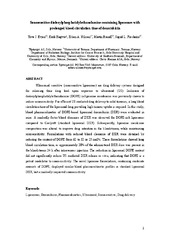| dc.contributor.advisor | Brandl, Martin | |
| dc.contributor.author | Evjen, Tove Julie | |
| dc.date.accessioned | 2011-05-31T08:56:38Z | |
| dc.date.available | 2011-05-31T08:56:38Z | |
| dc.date.issued | 2011-06-20 | |
| dc.description.abstract | Liposome encapsulation of cytotoxic drugs favours drug delivery to tumours and improves the therapeutic-to-toxicity ratio of conventional chemotherapy. A novel approach to further enhance the availability of liposomal drugs to tumour cells is to combine ultrasound (US) with US sensitive (sonosensitive) liposomes. US treatment of tumour tissue induces local drug release from the liposome carrier followed by increased drug uptake into tumour cells. The liposomes, however, should display properties that both favour high sonosensitivity and drug retention in the blood circulation prior to reaching the tumour tissue.
In the present study novel sonosensitive doxorubicin (DXR)-containing liposomes were developed. Inclusion of non-bilayer forming lipids in liposomal membranes was shown to significantly improve sonosensitivity. Two classes of liposomes based on distearoylphosphatidylethanolamine (DSPE) and dioleoylphosphatidylethanolamine (DOPE), respectively, were investigated. DOPE, displaying a more pronounced inverted cone shaped geometry than DSPE, was the most potent modulator of sonosensitivity. Inclusion of 25 mol% DOPE in liposome membranes comprising distearoylphosphatidylcholine, PEGylated phosphatidylethanolamine and cholesterol resulted in an up to 7-fold increased US-mediated DXR release in vitro. The postulated mechanism of drug release is disruption of PE-based liposomes on US exposure. We suggest that US energy triggers perturbations and/or lamellar to reverse hexagonal phase transitions in liposomal membranes comprising non-bilayer forming lipids, leading to drug release.
Selected liposome formulations were investigated in terms of blood pharmacokinetics in mice. Membrane composition was important for retaining DXR in blood circulation. Low levels of DOPE (25-32 mol%) were required to obtain long blood circulation times of DXR. Optimized DOPE-containing liposomes featured both sufficient blood circulation time and high in vitro sonosensitivity.
A significant tumour growth regression effect was demonstrated in tumour-bearing mice receiving prototype liposomes and US. The data support the concept that an US activated liposomal drug delivery system might enhance the therapeutic effect of chemotherapeutic drugs. | en |
| dc.description.doctoraltype | ph.d. | en |
| dc.description.popularabstract | Formålet med forskningen var å utvikle en teknologi som får kreftmedisin effektivt inn i kreftsvulsten. Kreftmedisinen blir pakket inn i nanopartikler bestående av et lipidskall som frakter medisinen til svulsten. Partiklene er så små at de kommer seg inn gjennom små hull i blodårene til svulsten. Lipidskallet til partiklene er utviklet slik at det beskytter kroppen mot kreftmedisinen når partiklene sprøytes inn i pasienten. Etter at partiklene har funnet veien til svulsten, vil ultralydbølger føre til at skallet åpner seg og medisinen slippes ut. På denne måten oppnås høyere konsentrasjon av medisinen i kreftsvulsten, samtidig som de friske cellene i kroppen beskyttes. Teknologien har gitt gode resultater i kreftsyke dyr, noe som er lovende for fremtidige utprøvninger i menneske | en |
| dc.description.sponsorship | Norsk forskningsråd, nærings-PhD. | en |
| dc.description | Papers number 1, 2, 3 and 4 of this thesis are not available in Munin: <br/>1. Evjen TJ, Nilssen EA, Røgnvaldsson S, Brandl M and Fossheim SL: 'Distearoylphosphatidylethanolamine-based liposomes for ultrasound-mediated drug delivery', European Journal of Pharmaceutics and Biopharmaceutics (2010) 75:327-333. (Publishers' restriction). Available at <a href=http://dx.doi.org/10.1016/j.ejpb.2010.04.012>http://dx.doi.org/10.1016/j.ejpb.2010.04.012</a>
<br/>2. Hagtvet E, Evjen TJ, Olsen DR, Fossheim SL and Nilssen EA: 'Ultrasound enhanced antitumour activity of liposomal doxorubicin in mice' (accepted manuscript version). Published version in Journal of Drug Targeting, Sep 2011, Vol. 19, No. 8, Pages 701-708, available at <a href=http://dx.doi.org/10.3109/1061186X.2010.551401>http://dx.doi.org/10.3109/1061186X.2010.551401</a>.
<br/>3. Evjen TJ, Nilssen EA, Barnert S, Schubert R, Brandl M and Fossheim S: 'Ultrasound- mediated destabilization and drug release from liposomes comprising
dioleoylphosphatidylethanolamine', European Journal of Pharmaceutical Sciences (2011) 42:380-386. (Publishers' restriction). Available at <a href=http://dx.doi.org/10.1016/j.ejps.2011.01.002>http://dx.doi.org/10.1016/j.ejps.2011.01.002</a> <br/>4.Evjen TJ, Nilssen EA, Fowler RA, Røgnvaldsson S, Brandl M and Fossheim S: 'Lipid membrane composition influences drug release from dioleoylphosphatidylethanolaminebased
liposomes on exposure to ultrasound', International Journal of Pharmaceutics (2011) 406:114-116. (Publishers' restriction). Available at <a href=http://dx.doi.org/10.1016/j.ijpharm.2010.12.026>http://dx.doi.org/10.1016/j.ijpharm.2010.12.026</a> | en |
| dc.identifier.uri | https://hdl.handle.net/10037/3373 | |
| dc.identifier.urn | URN:NBN:no-uit_munin_3096 | |
| dc.language.iso | eng | en |
| dc.rights.accessRights | openAccess | |
| dc.rights.holder | Copyright 2011 The Author(s) | |
| dc.subject.courseID | DOKTOR-003 | en |
| dc.subject | VDP::Medisinske Fag: 700::Helsefag: 800 | en |
| dc.subject | VDP::Medical disciplines: 700::Health sciences: 800 | en |
| dc.title | Sonosensitive liposomes for ultrasound-mediated drug delivery | en |
| dc.type | Doctoral thesis | en |
| dc.type | Doktorgradsavhandling | en |


 English
English norsk
norsk
